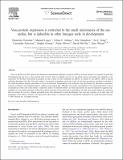| dc.contributor.author | Wessel, Gary | |
| dc.contributor.author | McClay, David | |
| dc.contributor.author | Oliveri, Paola | |
| dc.contributor.author | George, Sophie | |
| dc.contributor.author | Extavour, Cassandra | |
| dc.contributor.author | Song, Jia L. | |
| dc.contributor.author | Gustafson, Eric | |
| dc.contributor.author | Juliano, Celina E. | |
| dc.contributor.author | Lopez, Manuel | |
| dc.contributor.author | Voronina, Ekaterina | |
| dc.date.accessioned | 2009-07-09T19:58:08Z | |
| dc.date.issued | 2008 | |
| dc.identifier.citation | Voronina, Ekaterina, Manuel Lopez, Celina E. Juliano, Eric Gustafson, Jia L. Song, Cassandra Extavour, Sophie Georgeet al. 2008. Vasa protein expression is restricted to the small micromeres of the sea urchin, but is inducible in other lineages early in development. Developmental Biology 314, no. 2: 276-286. | en |
| dc.identifier.issn | 0012-1606 | en |
| dc.identifier.uri | http://nrs.harvard.edu/urn-3:HUL.InstRepos:3160487 | |
| dc.description.abstract | Vasa is a DEAD-box RNA helicase that functions in translational regulation of specific mRNAs. In many animals it is essential for germ line development and may have a more general stem cell role. Here we identify vasa in two sea urchin species and analyze the regulation of its expression. We find that vasa protein accumulates in only a subset of cells containing vasa mRNA. In contrast to vasa mRNA, which is present uniformly throughout all cells of the early embryo, vasa protein accumulates selectively in the 16-cell stage micromeres, and then is restricted to the small micromeres through gastrulation to larval development. Manipulating early embryonic fate specification by blastomere separations, exposure to lithium, and dominant-negative cadherin each suggest that, although vasa protein accumulation in the small micromeres is fixed, accumulation in other cells of the embryo is inducible. Indeed, we find that embryos in which micromeres are removed respond by significant up-regulation of vasa protein translation, followed by spatial restriction of the protein late in gastrulation. Overall, these results support the contention that sea urchins do not have obligate primordial germ cells determined in early development, that vasa may function in an early stem cell population of the embryo, and that vasa expression in this embryo is restricted early by translational regulation to the small micromere lineage. | en |
| dc.description.sponsorship | Organismic and Evolutionary Biology | en |
| dc.language.iso | en_US | en |
| dc.publisher | Elsevier | en |
| dc.relation.isversionof | http://dx.doi.org/10.1016/j.ydbio.2007.11.039 | en |
| dash.license | LAA | |
| dc.subject | small micromeres | en |
| dc.subject | sea urchin | en |
| dc.subject | vasa | en |
| dc.title | Vasa Protein Expression is Restricted to the Small Micromeres of the Sea Urchin, but is Inducible in Other Lineages Early in Development | en |
| dc.relation.journal | Developmental Biology | en |
| dash.depositing.author | Extavour, Cassandra | |
| dc.identifier.doi | 10.1016/j.ydbio.2007.11.039 | * |
| dash.authorsordered | false | |
| dash.contributor.affiliated | Extavour, Cassandra | |


